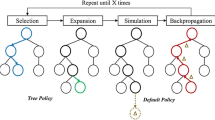Abstract
The manufacturing Cell Design Problem (MCDP) is a well-known problem for lines of manufacture where the main goal is to minimize the inter-cell moves. To solve the MCDP we employ the Shuffled Frog Leaping Algorithm (SFLA), which is a metaheuristic inspired on the natural memetic features of frogs. The frog tries to leap all over the search space for a better result until the stopping criteria is met. The obtained results are compared with previous approaches of the algorithm to test the real efficiency of our proposed SFLA. The results show that the proposed algorithm produces optimal solutions for all the 50 studied instances.
Access this chapter
Tax calculation will be finalised at checkout
Purchases are for personal use only
Similar content being viewed by others
References
Eusuff, M., Lansey, K.: Optimization of water distribution network design using the shuffled frog leaping algorithm. J. Water Resour. Plan Manag. 129, 210–225 (2003)
Burbidge, J.L.: Production flow analysis. Prod. Eng. 42(12), 742–752 (1963)
Kusiak, A.: The part families problem in flexible manufacturing systems. Ann. Oper. Res. 3, 279–300 (1985)
Xambre, A.R., Vilarinho, P.M.: A simulated annealing approach for manufacturing cell formation with multiple identical machines. Eur. J. Oper. Res. 151, 434–446 (2003)
Shargal, M., Shekhar, S., Irani, S.A.: Evaluation of search algorithms and clustering efficiency measures for machine-part matrix clustering. IIE Trans. 27(1), 43–59 (1995)
Seifoddini, H., Hsu, C.-P.: Comparative study of similarity coefficients and clustering algorithms in cellular manufacturing. J. Manuf. Syst. 13(2), 119–127 (1994)
Srinivasan, G.: A clustering algorithm for machine cell formation in group technology using minimum spanning tree. Int. J. Prod. Res. 32(9), 2149–2158 (1994)
Deutsch, S.J., Freeman, S.F., Helander, M.: Manufacturing cell formation using an improved p-median model. Comput. Ind. Eng. 34(1), 135–146 (1998)
Atmani, A., Lashkari, R.S., Caron, R.J.: A mathematical programming approach to joint cell formation and operation allocation in cellular manufacturing. Int. J. Prod. Res. 33(1), 1–15 (1995)
Adil, G.K., Rajamani, D., Strong, D.: A mathematical model for cell formation considering investment and operational costs. Eur. J. Oper. Res. 69(3), 330–341 (1993)
Purcheck, G.: A linear-programming method for the combinatorial grouping of an incomplete set. J. Cybern. 5, 51–58 (1975)
Olivia-Lopez, E., Purcheck, G.: Load balancing for group technology planning and control. Int. J. MTDR 19, 259–268 (1979)
Boctor, F.F.: A linear formulation of the machine-part cell formation problem. Int. J. Prod. Res. 29(2), 343–356 (1991)
Soto, R., Kjellerstrand, H.: Durn, O., Crawford, B., Monfroy, E., Paredes, F.: Cell formation in group technology using constraint programming and Boolean satisfiability. Expert Syst. Appl. 39, 11423–11427 (2012)
Durán, O., Rodriguez, N., Consalter, L.: Collaborative particle swarm optimization with a data mining technique for manufacturing cell design. Expert Syst. Appl. 37(2), 1563–1567 (2010)
Wu, T., Chang, C., Chung, S.: A simulated annealing algorithm for manufacturing cell formation problems. Expert Syst. Appl. 34(3), 1609–1617 (2008)
Venugopal, V., Narendran, T.T.: A genetic algorithm approach to the machine-component grouping problem with multiple objectives. Comput. Indu. Eng. 22(4), 469–480 (1992)
Gupta, Y., Gupta, M., Kumar, A., Sundaram, C.: A genetic algorithm-based approach to cell composition and layout design problems. Int. J. Prod. Res. 34(2), 447–482 (1996)
Oliveira, S., Ribeiro, J.F.F., Seok, S.C.: A spectral clustering algorithm for manufacturing cell formation. Comput. Ind. Eng. 57(3), 1008–1014 (2009)
Bhattacharjee, K.K., Sarmah, S.: Shuffled frog leaping algorithm and its application to 0/1 knapsack problem. Appl. Soft Comput. 19, 252–263 (2014)
Lion, S., Atiquzzaman, M.: Optimal design of water distribution network using shuffled complex evolution. J. Instrum. Eng. 44, 93–117 (2004)
Acknowledgments
Ricardo Soto is supported by Grant CONICYT/FONDECYT/INICIACION/11130459, Broderick Crawford is supported by Grant CONICYT/FONDECYT/1140897, and Fernando Paredes is supported by Grant CONICYT/FONDECYT/1130455.
Author information
Authors and Affiliations
Corresponding author
Editor information
Editors and Affiliations
Rights and permissions
Copyright information
© 2016 Springer International Publishing Switzerland
About this paper
Cite this paper
Soto, R., Crawford, B., Vega, E., Johnson, F., Paredes, F. (2016). Solving Manufacturing Cell Design Problems Using a Shuffled Frog Leaping Algorithm. In: Gaber, T., Hassanien, A., El-Bendary, N., Dey, N. (eds) The 1st International Conference on Advanced Intelligent System and Informatics (AISI2015), November 28-30, 2015, Beni Suef, Egypt. Advances in Intelligent Systems and Computing, vol 407. Springer, Cham. https://doi.org/10.1007/978-3-319-26690-9_23
Download citation
DOI: https://doi.org/10.1007/978-3-319-26690-9_23
Published:
Publisher Name: Springer, Cham
Print ISBN: 978-3-319-26688-6
Online ISBN: 978-3-319-26690-9
eBook Packages: Computer ScienceComputer Science (R0)




